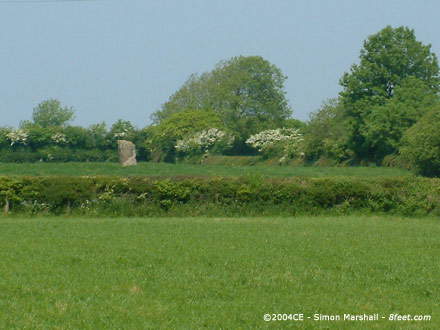We did a circular walk, parking just off the B4306 to the south east of the burial chamber (SN486123) and following an extremely overgrown footpath onto the common.
With an eight figure grid reference from Coflein (SN48541328) I used the GPS to navigate. There were a lot of brambles and general undergrowth in the way, and Lou was wearing sandals, so we ended up hopping from boulder to boulder. We eventually arrived at the spot where the GPS thought we should find the chambers – the top of a large rocky outcrop. Of course there were no burial chambers on top of the outcrop. It eventually dawned on me that the site was directly below us, a short distance as the crow flies, but a long way down (here’s the view we got).
The climb down to the chambers was laborious because of the brambles, but on the flat the foliage was a little less daunting. There’s a mess of rubble and vegetation at the base of the cliff, some of which is clearly cairn material or collapsed chamber. The two capstones are really easy to spot, as are some of the remaining orthostats (the easterly chamber still has one apparently in place). The cliff next to the chambers dominates them, and presumably blocks out quite a bit of sunlight (not for us thankfully). The landscape surrounding the chambers is very distinctive, with another outcrop to the north east, similar to the one by the chambers. This must have been pretty poor agricultural land when the chambers were built.
On the way back to the car we had a go at finding the cairns to the north west of the chamber, but the bumps on the ground weren’t convincing. We did meet some friendly horses though. From the summit of Mynydd Llangynderyrn we walked back to the main road, rejoining it near the milestone (SN481127). This was a lot easier than our route in!
NB. The chambers are easy to get at from any direction other than the south east (the way we approached them). Visit in the winter for a less bramble orientated experience.
































